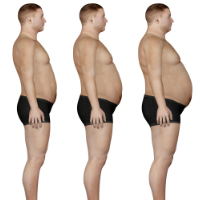Obese Adult Californians Are Getting Fatter Faster

Adult Californians are fat and getting fatter fast.
A new report (pdf) from the UCLA Center for Health Policy Research says 24.8% of adult Californians were obese in 2011-12, compared to 19.3% in 2001. For the math challenged, that is nearly a 30% increase in 10 years.
There wasn’t much change in the percentage of overweight adults who weren’t obese; they edged down from 35.5% to 35%. But adults of normal weight declined from 43% to 38.6%. The only good news for adults was the presence of fewer that were underweight, down from 2.2% to 1.6%.
The data for the study was mined from the California Health Interview Survey (CHIS), which is affiliated with the UCLA Fielding School of Public Health, thus accounting for the age of the stats.
Health experts have been wringing their hands for years over the escalating rate of obesity, especially among children. Those numbers held steady over the past decade. Around 17% of California kids were obese and 16% were otherwise overweight.
The Robert Wood Johnson Foundation says that same leveling off nationwide inspired it to change the name of its 11th annual “F as in Fat” (pdf) report in 2014 to “The State of Obesity: Better Policies for a Healthy America.” After 10 years of “F” grades, America was the beneficiary of grade inflation that deemed it not failing for simply not getting worse.
California, despite its dangerously high obesity rates, is actually one of the slimmer states. The National Health and Nutrition Examination Survey indicated that approximately 35% of adults were obese in 2011-12.
Obesity is a significant risk factor for Type-2 diabetes, heart disease, stroke and cancer. Overweight Californians cost society $21 billion a year (pdf) when you count health care, lost productivity, family costs and government expenditures, according to the California Center for Public Health Advocacy.
Those costs are not evenly spread. The UCLA report found obesity prevalence varies widely by county. San Francisco County was on the low end at 11% and Imperial County topped out at 42%. Six counties experienced more than a 10-percentage-point jump in a decade: Tulare, Tehama/Glenn/Colusa, Solano, Imperial, Santa Cruz, and Napa.
The county differential was reflective of the most salient data: poor people are fatter.
“Thirty-one percent of adult Californians with incomes below 200 percent of the Federal Poverty Level (FPL) were obese compared to 20 percent with incomes at or above 400% FPL.”
Income levels had a lot to do with the racial disparity in the numbers. African-Americans, Latinos and American Indians were more obese that whites, but all the groups experienced an increase over a decade’s time.
The report does not discount the roles that genetics and individual behavior play in obesity, but “neighborhoods and social environments have been increasingly implicated as impediments to maintaining a healthy lifestyles. Access to healthy foods, better health care, exercise venues in safe areas are considered keys to containing the bloat before the Baby Boomers explode.
–Ken Broder
To Learn More:
Nearly a Quarter of Californians Are Obese, Study Finds (by Hannah Guzik, California Health Report)
Why Are Americans Growing Obese? Blame Richard Nixon and Earl Butz (by Matt Bewig, AllGov)
The State of Obesity (by J. Levi, L. Segal, R. St. Laurent and J. Rayburn, Robert Wood Johnson Foundation) (pdf)
Obesity in California (by Joelle Wolstein, Susan H. Babey and Dr. Allison L. Diamant, UCLA Center for Health Policy Research) (pdf)
- Top Stories
- Controversies
- Where is the Money Going?
- California and the Nation
- Appointments and Resignations
- Unusual News
- Latest News
- California Forbids U.S. Immigration Agents from Pretending to be Police
- California Lawmakers Urged to Strip “Self-Dealing” Tax Board of Its Duties
- Big Oil’s Grip on California
- Santa Cruz Police See Homeland Security Betrayal in Use of Gang Roundup as Cover for Immigration Raid
- Oil Companies Face Deadline to Stop Polluting California Groundwater





